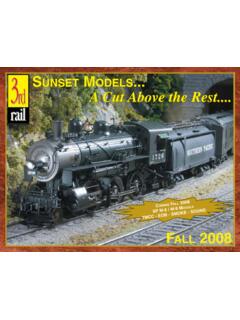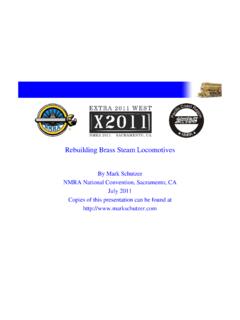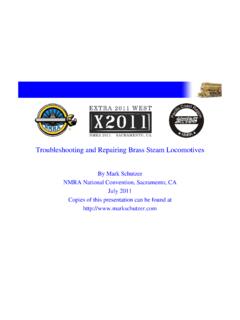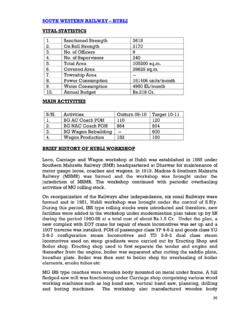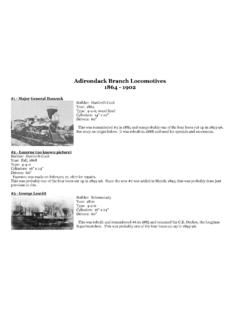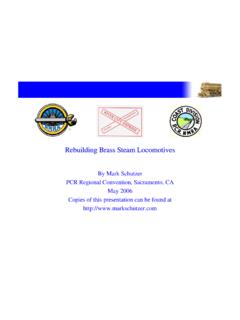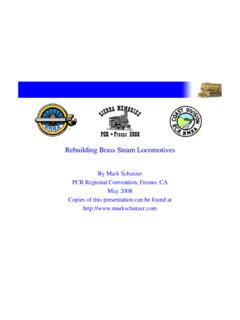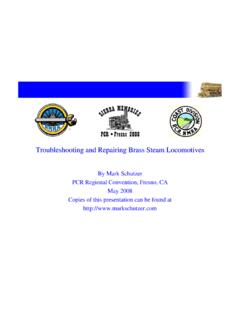Transcription of Run 231 October / November 2008 - 3rd Rail
1 Run 231 October / November :OGRR 231 cover 7/30/08 4:27 PM Page 1O GAUGE RAILROADING October / November 200833 Southern Pacific s 12 Class AM2(articulated Mogul) cab forwards of the1930s were single-expansion, simple artic-ulateds with a 4-6-6-2 wheel , Baldwin originally built them in 1911 as Class MM2 (Mallet Mogul) 2-6-6-2 double-expansion, compoundMallets for passenger service through theSierra Nevada mountain range. Distinctivecharacteristics of these early cab forwardsincluded their flat-faced cabs and externalhigh-pressure steam pipes from the smoke-box to the front engine s cylinders. Trailingthese locomotives were the exclusively SPand exceptionally homely half-round whaleback oil tenders. Soon after the MM2s started workingpassenger runs, tracking problems at speedresulted in frequent derailments of thetwo-wheel pilot trucks, and the locomotives to four-wheelpilot trucks solved the derailment prob-lem, but arrival of the faster and more effi-cient 2-10-2s quickly relegated the MM2sto freight duty.
2 In the mid-1920s, all 12 ofthe small cab forwards were set 1929, SP s Sacramento locomotiveshops rebuilt three of the 4-6-6-2 cab for-ward Mallets into simple artic-ulateds with sport cabs, whichbecame the road s first ClassAM2s. The remaining ninederelicts languished until themid-1930s when they tooexited SP s shops as AM2s. All12 of the rebuilt and reclassifiedAM2s worked heavy freightsthrough the WWII yearsbetween Eugene and Portland,Oregon, but were dismantledsoon after the war and FeaturesThe all-brass 1:48 scalemodel of the AM2 from 3rdRail is the first of its type in Ogauge. I can state unequivocallythat even for a cab forward, it sdifferent. But on the rails, the4-6-6-2 looks downright natural at thehead of a train of steam -era freight cars,especially a consist of 1:48 scale woodsheathed boxcars and reefers, with a fewsteel cars mixed in for visual spice.
3 Otherthan driver diameter, I don t have anydimensional information to check the 3rdRail model against, but my calipermicrometer showed the drivers slightlylarger than the 63 of a full-scale AM2. Tome, this scale discrepancy of approxi-mately isn t all that , the 3rd Rail model measures 27 (scale 108 ) across the coupler knuckles,but this measurement includes the longdrawbar necessary for running the loco-motive on tight curves and also the over-sized tinplate coil evaluation AM2 with cab number3902 wore SP s post-WWII trim, with sil-ver paint on the front for visibility andSouthern Pacific in large lettering on thetender. At this writing in June 08, cabnumber 3907 is also available in postwarmarkings, and number 3900 is decoratedin SP s prewar trim.
4 Prewar engines lackedthe silver paint on their fronts while letter-ing on their tenders stated Southern PacificLines. Additionally, the cab front detailson 3rd Rail s postwar and prewar versionsof the AM2 differ slightly from each other. As with previously released 3rd Raillocomotives, the AM2 is hand-built fromsheet and bar stock brass. Low reliefdetails, such as rivets on the cab, bolt headson the firebox, and woodgrain planking on3rd Rail Southern Pacific 4-6-6-2 Class AM2 Review and Photos by George BrownOpen hatches reveal the valves and lineshoused inside the turret 231 BRD 7/30/08 2:20 PM Page 33O GAUGE RAILROADING October / November 200834the tender, are photo-etched into the sheetbrass before assembly. The numerous sep-arately applied details, like boiler backheadgauges and valves, classification andmarker lamps, air pumps, generator, andso forth, are lost wax castings.
5 Various sizesof brass wire serve as handrails and plumb-ing that often fit into cast fittings andunions. A flywheel-equipped 9000-seriesPittman motor powers all 12 driversthrough 3rd Rail s inimitable Quiet Drivemechanism. Except for the toothedpolyurethane timing belt and matchingplastic drive pulleys, the entire drive mech-anism is metal with steel drive shafts thatrun in ball bearings, steel worm gears,bronze axle gears, cast gearboxes, and amachined steel universal joint between thefront and rear engines. Two painted figures ride in theirrespective crew stations inside the illumi-nated cab and behind glazed white incandescent bulbs light theheadlight, number boards, and directionalbackup light.
6 At both ends of the AM2,LEDs illuminate the green classificationand red marker lamps. All six driver axles run in sprung jour-nals while realistic articulated side rodsallow independent vertical movement ofeach axle. Other operating features includeopening cab roof vent, cab doors, and tur-ret cover hatches. A hinged step platebetween the rear platform and tender visu-ally fills the wide gap between the locomo-tive and tender as well as partially hides thetether wires and plug. This 8-wire tethercable connects the tender-resident LionelTrainMaster Command Control and TrainAmerica Studios Engineer-On-Boardelectronics to the locomotive s motor,lights, and TAS Turbo Smoke electronics and speakeralso reside in the tender and reproduceLionel s generic repertoire for a simple, sin-gle-expansion articulated, which includesan automatic bell ringer and the hooterwhistle of N&W fame.
7 Controls for thecommand and sound systems are hiddenunder the opening water Pacific s exclusive and unusual whale-back tender wears the road s post-WWII for 3-rail track have a truck-mounted, coil-operated 231 BRD 7/30/08 2:20 PM Page 34O GAUGE RAILROADING October / November 200835 For conventional transformer-controlled operation, 3rd Railthoughtfully includes a factory-installed 9-volt alkaline battery. This bat-tery provides RailSounds backup during power cycles for direction con-trol but is not necessary in command operation. For running the AM2exclusively in command operation, I recommend removing the though alkaline batteries are a vast improvement over the acid drycells of years ago, I have seen depleted alkaline batteries leak and make amess, or an overall perspective or close-up, the AM2 s paint and letter-ing is about as flawless as a manufactured model can get.
8 My only dingof an otherwise magnificent model is the bright finish on the wheels anddriver rims. I initially took exception to the pilot truck, but upon study-ing the real AM2s inside frame pilot trucks in old photos, they too wereunusually plain, exposed, and .. well .. of ugly that has been my impression of the SP whalebacktender for years. When Scott Mann, president of Sunset/3rd Rail, con-tacted me about reviewing the AM2, I was a bit concerned about how Iwould deal with its tender in my review. But a few weeks later with thecab forward just unpacked and sitting on my desk, I suddenly realized itstender wasn t ugly at all. In fact, I found it rather intriguing. After a fewmoments looking at the locomotive and tenderfrom my elevated perspective rather than the lowviews in photos taken at trackside, I half-round tank superstructure, the wood-planked decking around the oil tank cap and waterhatches, the high-low handrails, the backup light,the catwalks along the sides of the tank, the stepsup to the decking all these components made fora handsome and visually striking industrial designof maximum utility and strength.
9 All things con-sidered, I now see the SP whaleback tender as ratherhandsome in its select TracksideMost scale articulateds are long and even thoseengineered for 3-rail operation usually need aSlide switch under the cab selects steam exhaust chuff rate. Pilot detailsinclude the coupler cut lever and link to the scale dummy main and side rods complement the complete Walschaerts valve gearand other details such as the brake shoe hangers and boiler plumbing. Thevent on the cab roof swings open or 231 BRD 7/30/08 2:20 PM Page 35O GAUGE RAILROADING October / November 200836 Three pickup rollers help to provide contin-uous electrical power in long switches curve of O72, but not so withthe AM2. It is advertised as an O54 engineor 48 minimum radius for running in either direction aroundthree of my four O54 curves, the 4-6-6-2performed well but naturally looked a bitawkward in these tight curves.
10 But in thefourth and slightly tighter curve, a driverflange scraped against the articulatedsteam exhaust pipe that s underneath thesmokebox. On O72 or wider curves, the cab for-ward was in its element with smooth andfaultless operation over a cumulative eight-plus hours of running, even through mymodern-era Lionel O72 turnouts. I wasalso pleasantly surprised with the moder-ate amount of cab and boiler overhang onmy O72 curves. For an articulated, theAM2 is not a particularly large locomotive ,so it looked great on my small layout. My only operational criticism is withthe EOB motor driver electronics. At lowspeeds, rapid electrical pulses do an excel-lent job of running the motor at a precisespeed with exceptional torque.
